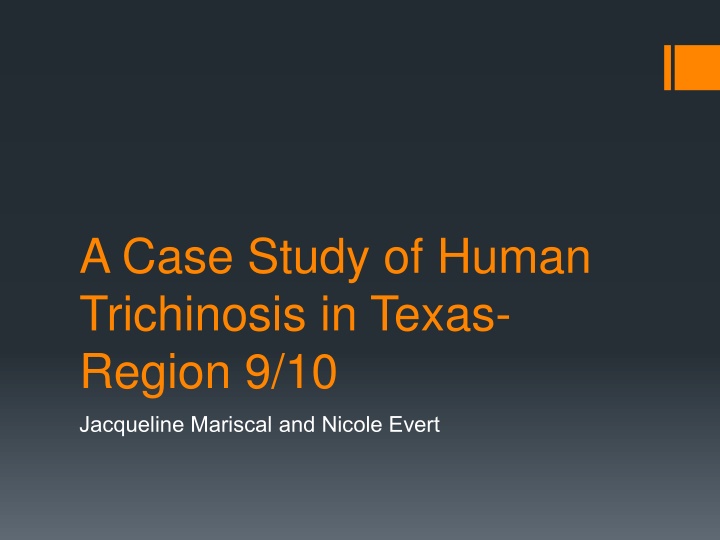Case Study of Human Trichinosis in Texas Region
Human trichinosis is a parasitic disease caused by consuming undercooked or raw meat infected with Trichinella larvae. This case study details the presentation, diagnosis, and treatment of a 36-year-old female physician from San Angelo, Texas, who manifested symptoms after consuming bear meat from Alaska. The investigation traced the source of infection to the consumption of bear meat obtained from relatives in Alaska. The patient's husband also exhibited symptoms, reinforcing the importance of proper meat preparation to prevent trichinosis.
Download Presentation

Please find below an Image/Link to download the presentation.
The content on the website is provided AS IS for your information and personal use only. It may not be sold, licensed, or shared on other websites without obtaining consent from the author.If you encounter any issues during the download, it is possible that the publisher has removed the file from their server.
You are allowed to download the files provided on this website for personal or commercial use, subject to the condition that they are used lawfully. All files are the property of their respective owners.
The content on the website is provided AS IS for your information and personal use only. It may not be sold, licensed, or shared on other websites without obtaining consent from the author.
E N D
Presentation Transcript
A Case Study of Human Trichinosis in Texas- Region 9/10 Jacqueline Mariscal and Nicole Evert
Trichinellosis Overview Parasitic disease caused by eating undercooked or raw meat infected with Trichinella larvae Several different species of Trichinella can cause human disease Most common is Trichinella spiralis, which has a global distribution and commonly found in pigs. Other Trichinella species are less commonly reported as the cause of human disease and may be found in different parts of the world Trichinella nativa in Alaska bear meat and walrus meat
Trichinellosis Overview Incubation 2-8 weeks Hallmark symptoms include: fever, myalgia, periorbital edema and eosinophilia Diagnosis Demonstration of Trichinella larvae in tissue biopsy Detection of Trichinella antibody Treatment Albendazole or Mebendazole
Index Patient 36 yr. old female- Physician from San Angelo, TX Presented to primary care physician (PCP) on January 29th, 2015 with: Fever (103 F - Onset 1/24/15) Myalgia Nausea Vomiting Headache Facial pain and pressure Diagnosis: Flu Treatment: Tamiflu; Levaquin 500 mg Shot of Kenalog and Rocephin
Index Patient February 2nd: Fevers and other symptoms persisted Night sweats Headache Facial pain and pressure Abdominal pain Lab Analysis White blood cell count: 15,000 with 25% eosinophils February 3rd: Patient relays to PCP that family consumed bear meat obtained from relatives in Alaska February 4th: Trichinella Antibody by ELISA conducted and detected
Investigation Bear meat was obtained from family members hunting in Soldotna, AK. Froze the meat then cooked it by grilling it for hamburgers on December 18th, 2014 Husband and daughter also consumed the meat http://www.idcide.com/i/mc2/ak/soldotna.gif
Probable Cases Both were symptomatic Husband (36 years old)- Date of Onset: 1/15/15 Fever (101.5), myalgia, periorbital edema, eosinophilia (31%), no GI illness, not as much muscle wasting Serologically negative 2/4/15 (ARUP) Daughter (1 year old)- Date of Onset: 1/27/15 Fever (104.4), eosinophilia (33%), rash (unknown etiology), lethargic, and anorexic x 3 days Serologically negative 2/4/15 (ARUP)
Bear-y Good Time Family members in Alaska were contacted to obtain bear meat for testing through the CDC Family provided frozen, grounded bear meat to local Public Health Center, who sent it to Alaska State Public Health Lab (ASPHL) in Anchorage, AK on March 17th, 2015 Meat was examined by CDC and larvae was found The specimen was tested by PCR using primers that target rRNA gene (ITS1-ITS2 region) of Trichinella spp. The amplified product was sequenced and the DNA sequencing analysis data was similar to the Trichinella nativa ITS1-ITS2 region
Trichinellosis: Prevention and Control Cook meat to safe temperatures. 160 F (71 C) Wash your hands with warm water and soap after handling raw meat. Curing (salting), drying, smoking, or microwaving meat alone does not consistently kill infective worms Homemade jerky and sausage were the cause of many cases of Trichinellosis reported to CDC in recent years.
Trichinellosis: Prevention and Control Freeze pork less than 6 inches thick for 20 days at 5 F (- 15 C) to kill any worms. Freezing wild game meats, unlike freezing pork products, may not effectively kill all worms because some worm species that infect wild game animals are freeze-resistant. Trichinella nativa in Alaska bear meat and walrus meat is cold resistant; unlike the T. spiralis larval cysts found in pork, freezing will NOT kill T. nativa larval cysts found in arctic meats1 Clean meat grinders thoroughly after each use.
Cases of Trichinellosis in the United States reported to CDC by year, 1947-2007 Source: http://www.cdc.gov/parasites/trichinellosis/epi.html
Number of Reported Trichinellosis cases, by source of infection United States, 1975 2010. Source: http://www.cdc.gov/parasites/trichinellosis/epi.html
Reported Cases of Trichinellosis in Texas, 2003-2014 2012 Williamson County Myalgia Trich AB+ LTFU Cameron County Fever, myalgia, eosinophilia & periorbital edema Trich AB+ Ate pork and hamburger *preliminary data
Reported Cases of Trichinellosis in Texas, 2003-2014 2012 Harris County Eosinophilia Trich AB+ Travel to MX Reported eating pork from Mexico
Reported Cases of Trichinellosis in Texas, 2003-2014* 2014* Travis county Fever, chills, cough, myalgia, periorbital pain, eosinophilia and weakness Trich AB+ Ate wild bear skewers while hunting in Alaska Harris county Fever and myalgia Ate pork and hamburger Trich AB+ *preliminary data
Conclusions In the United States, Trichinellosis cases are reported to CDC much less commonly now than in the past During 2008-2010, 20 cases were reported to CDC each year on average. The overall number of cases reported has decreased because of: Improved pig-raising practices in the pork industry Commercial and home freezing of pork Public awareness of the danger of eating raw or undercooked meat products. Since 2003, there have been only 5 cases reported in Texas
Conclusions Healthcare providers should consider Trichinosis in any patient with the classic constitutional symptoms following gastrointestinal illness and a history of recent wild game consumption. Testing of sera for Trichinella antibodies can be done through commercial laboratories or CDC Muscle biopsies are not commonly performed Testing of meat for Trichinella larvae can be performed by the CDC CDC specimen submission form 50.34:http://www.cdc.gov/laboratory/specimen- submission/form.html
Questions? Trichinella nativa.jpg























